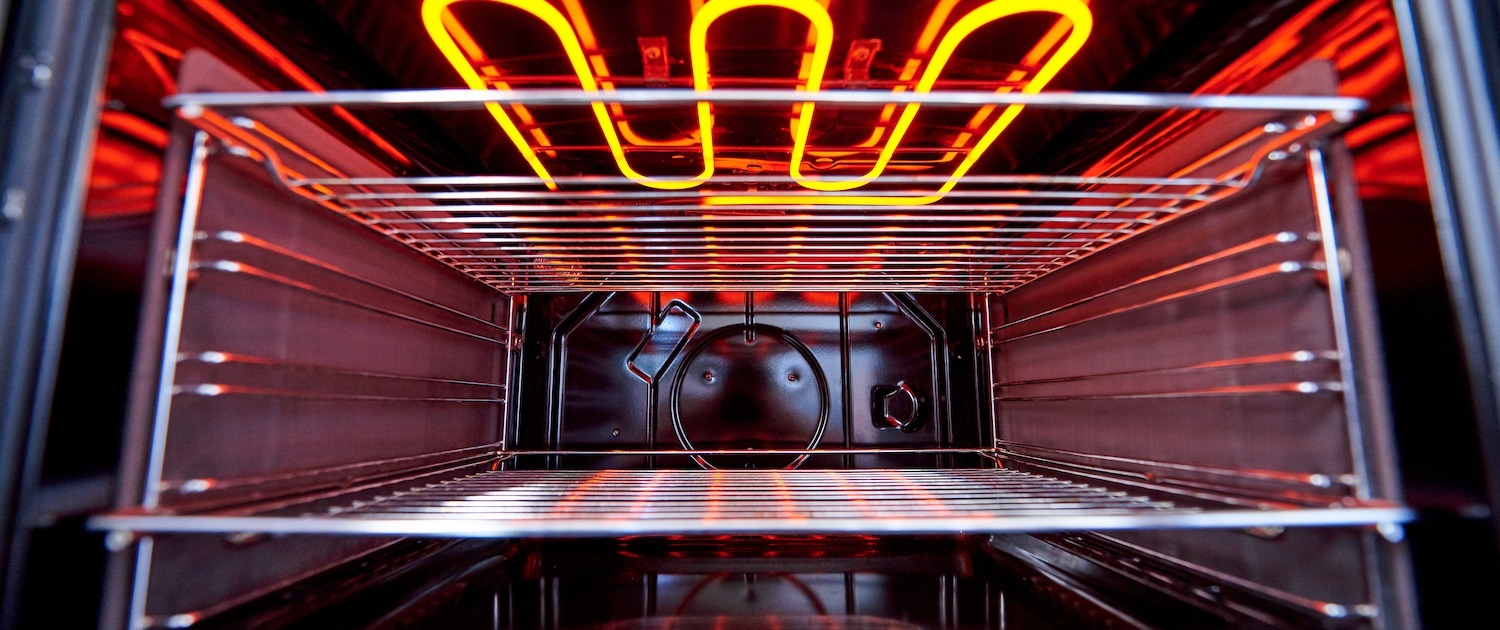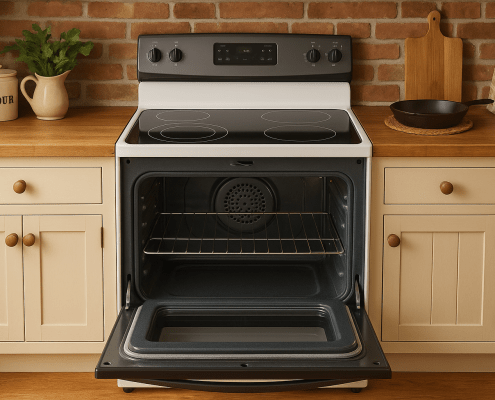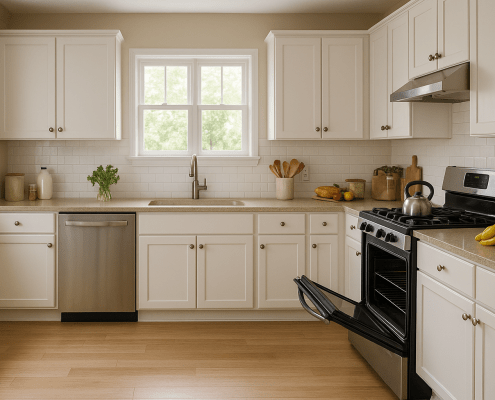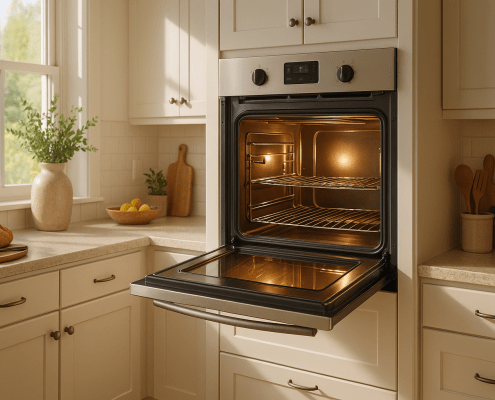How Does a Self-Cleaning Oven Work?
APP Expert / Friday November 19, 2021
Tired of battling stubborn oven grime, only to find that self-cleaning feature might not be as straightforward as it seems? Don’t hit that start button just yet! Learn crucial safety tips and get the most out of your oven’s self-cleaning function with our comprehensive guide—and if you prefer the DIY route, we’ve got a helpful how-to video ready for you below.
Few household chores are quite as much of a pain as cleaning your oven. All that caked on grease and crud, the weird angle you have to bend yourself into to reach the corners, the chemical cleaners, the endless scrubbing in the dark–it’s the worst. So, of course, a self-cleaning oven seems like the perfect fix, right?
Before you go pressing start on that fancy feature, you should educate yourself, both for your own safety, and for the longevity of your oven. Using the self-cleaning feature improperly could cause harm to your appliance, your home, or yourself. In this guide, we’ll walk you through the do’s and don’ts of your oven’s self-cleaning function.
How Does A Self-Cleaning Oven Work?
Self-cleaning ovens work in one of two ways: either by baking away grime at an extremely high heat (GE ovens will heat to 880° F, or 471° C, during self-cleaning) or by blasting your oven’s interior with steam to loosen and soften food debris. That said, “self-cleaning” isn’t an entirely accurate term. First of all, there will always be something to wipe up at the end of the cycle, be it ash or loosened grime. Second, many self-cleaning ovens recommend maintaining a regular manual cleaning schedule of about once per month, and even suggest pre-cleaning the oven before running the cycle. Still, high-heat self-cleaning ovens definitely cut down on the amount of elbow grease required to get rid of crud. Just make sure you know what
Steam-based Cleaning
In thirty minutes to an hour, a steam-based cleaning system can soften and loosen stains and food remains in your oven, making them easier to wipe up. Steam-based cleaning is a newer technology, safer than self-cleaning. It is intended for smaller stains and spills, and likely will not completely remove old, baked stains on its own. Typically, to use this feature you pour a cup of distilled water into the oven floor, shut the oven door, and engage the steam cleaning cycle. Over the next half hour to hour, the interior temperature rises to around 250° F, hot enough to turn that water into steam, which will loosen food remains, making them easier to wipe up.
Steam-based cleaning will do a decent job of getting the lower half of your oven clean, but is less effective at cleaning debris higher up on the oven walls or ceiling. You will likely still need to do some scrubbing to completely clean your oven, but in exchange you avoid many of the risks present in using the high-heat cleaning feature.
High-heat Cleaning
In a high-heat model, the self-cleaning cycle will bring the temperature in the oven to between 800 and 1,000 degrees Fahrenheit, depending on the oven model. For safety, the oven door automatically locks, and then, over the course of a few hours, any food left in the oven is incinerated. What’s left behind is ash that can be wiped away with a damp towel once the cycle is complete (and the oven has been allowed to cool).
High-heat cleaning is effective at getting rid of deeply caked on grime, reducing what might’ve taken you an hour of scrubbing to ash. It can take several hours to complete a cycle, though. The high heat also poses certain risks that you should account for before running a self-cleaning cycle. We’ll go over what you should watch out for and the steps you can take to avoid problems in the next section.
What To Consider Before Using The Self-Cleaning Feature
It is vitally important that you review your oven’s manual before using the self-cleaning cycle. Using the cycle incorrectly could damage the appliance or cause serious harm to you or your home! Even when done right, though, you risk one or more oven components breaking or melting from prolonged exposure to high heat.
Whether or not you decide to use your oven’s self-cleaning feature, it’s good to be educated about it. Below, we’ve covered some of the most common mishaps and problems you may encounter, and provided some tips on how to reduce the risk of something going wrong while your oven bakes away grime.
Damage To Internal Parts
Running your oven at 1,000° F might give you pause, and for good reason. The components in home ovens aren’t designed to sustain that much heat, and there’s a pretty good chance that one or more parts in your oven will break if the cycle is run too long. Most likely to go are the thermal fuses, which are safety measures that control just how hot an oven is allowed to get before it is shut off. If these fuses are blown and the oven doesn’t stop working entirely, other parts like the control panel, thermostat, and door locking mechanism could also wind up damaged.
Repeated and excessive use of a high-heat cleaning cycle could render more durable parts like the heating element brittle and could cause them to break. In some rare cases, the glass front of your oven could crack or shatter.
To mitigate damage to your oven with a high-heat cleaning cycle:
- Make sure that all pots, pans, grates and any bits of debris like aluminum foil are removed from the oven before beginning. If aluminum foil is allowed to melt, it could damage the walls or floor of your oven.
- Run the self-cleaning cycle for the shortest amount of time possible. This will reduce the risk of overheating and also mitigate energy consumption.
- Refer to your oven’s manual regarding how often the self-cleaning cycle should be run. Some experts advise running the self-cleaning cycle no more than once a year.
- If a part does break, don’t fret, it could be a relatively cheap and easy fix. AppliancePartsPros.com has the OEM oven parts that can replace any broken components.
Smoke, Odors, and Carbon Monoxide
Food material burnt off during a self-cleaning cycle can smell pretty foul, producing smoke that could set off your smoke detectors. Such fumes, aside from being unpleasant, can be irritating to pets and people, particularly those with respiratory issues. On top of this, carbon monoxide, an odorless, tasteless, colorless poison gas, can be produced during a high-heat self-cleaning cycle.
To mitigate fumes, smoke, and the risks posed by carbon monoxide exposure:
- Make sure you have a carbon monoxide detector installed in your home. It will alert you if there is carbon monoxide in the air.
- Pre-clean the oven to make sure you’ve gotten rid of as much surface grime as you can. Wipe it down with a damp rag. Cleaning up large chunks of food matter can help reduce the amount of smoke produced.
- Turn on your oven’s exhaust fan if it has one to dissipate fumes.
- Open the windows in your kitchen to allow for ample ventilation.
Fire Hazards
When a high-heat cleaning cycle runs at such high temperatures, it shouldn’t come as a surprise that there’s a risk of something catching fire. Grease and spilled food debris from that pizza you made last week could turn into a flame on the floor of your oven during a high-heat cleaning cycle.
If this happens, do not open your oven. Allow the fire to burn itself out. Opening the oven door could oxygenate the flame, making it far worse, and it will fill your kitchen with intense heat, which could spark fires elsewhere.
To avoid fires during the self-clean cycle:
- Remove any pots, pans, grates, or foil stored inside. Grease baked onto shelves, in particular, can catch fire.
- Pre-clean your self-cleaning oven, making sure to get rid of the worst grease spots, spills, and caked on debris. Remove any bits of food you find.
- If possible, run the cycle for a shorter amount of time. The longer the cycle runs, the greater the risk of oven components overheating. If a thermal fuse blows, it could lead to other parts overheating and potentially even catching fire.
Burns
High temperatures can pose a serious burn risk! While steam-based self-cleaners typically don’t climb too high, high-heat cleaners, reaching temperatures upwards of 1000° F, can definitely do harm. The front of the oven, and potentially the top, will become very warm while the cycle is running, and it will take time for the oven to cool to a safe temperature. This is not as great a problem on steam-based cleaners, as they only climb to about 250° F, which means the exterior of the oven shouldn’t get too hot. That said, 250° F is nothing to sniff at! Remember to let the oven cool after a cycle before opening it.
Here’s how to protect yourself and your loved ones from burns:
- Keep pets and children out of the kitchen while the cycle is running. You don’t want to risk someone bumping up against that hot glass!
- Allow time for the oven to cool completely after the cycle has ended before opening it.
- Never open the oven door immediately after the cycle has finished. The temperatures will still be incredibly high, and could start fires as the heat leaves the oven!
Wrapping Up
So, now you know the pros and cons of self-cleaning ovens. It’s up to you to decide whether you’ll use the feature and cook away grime or stick to a slightly more labor intensive manual cleaning schedule.
If you need any replacement parts for your appliances, you can enter your model number at AppliancePartsPros.com to locate and order them quickly. Most orders arrive in just two business days, and we have tons of great information in our repair help section and YouTube videos to help you troubleshoot.
Stay connected with the latest DIY tips, tutorial videos, and repair guides by following us on Facebook, Instagram, and Twitter. We love hearing about your repair stories and successes. If you need more help or want personalized guidance, feel free to contact or call us at 877-477-7278. We’re ready to help you take on your next project with confidence!
Since 1999, AppliancePartsPros.com has helped millions of people repair their broken appliances by providing high-quality original parts at well below retail prices, free support and troubleshooting, and award-winning customer service from an expert, friendly, US-based customer support team!
Hi! I’m Matt H., and I’m thrilled to be your guide through the world of appliance repair with over 25 years of invaluable experience in the industry.
From the early days of my career, I have been deeply passionate about appliances and their inner workings. Over the years, I’ve seen it all – from vintage models to the latest cutting-edge technology – and I’ve dedicated myself to mastering the art of repair. With a toolbox in one hand and a wealth of knowledge in the other, I’ve tackled every challenge that has come my way, learning and growing with each repair.
Join me as we dive into the intricacies of appliance repair. From step-by-step repair guides to explanations of common problems and their solutions, I’ll be here to simplify the repair process and empower you with the knowledge you need to keep your appliances running smoothly.
Feel free to explore our blog, ask questions, and leave comments – this platform is a space for learning, sharing, and growing together. Let’s work together to ensure that your appliances continue to serve you for years to come.
Thank you for joining me on this journey, and I look forward to being your go-to resource for all things related to appliance repair!





